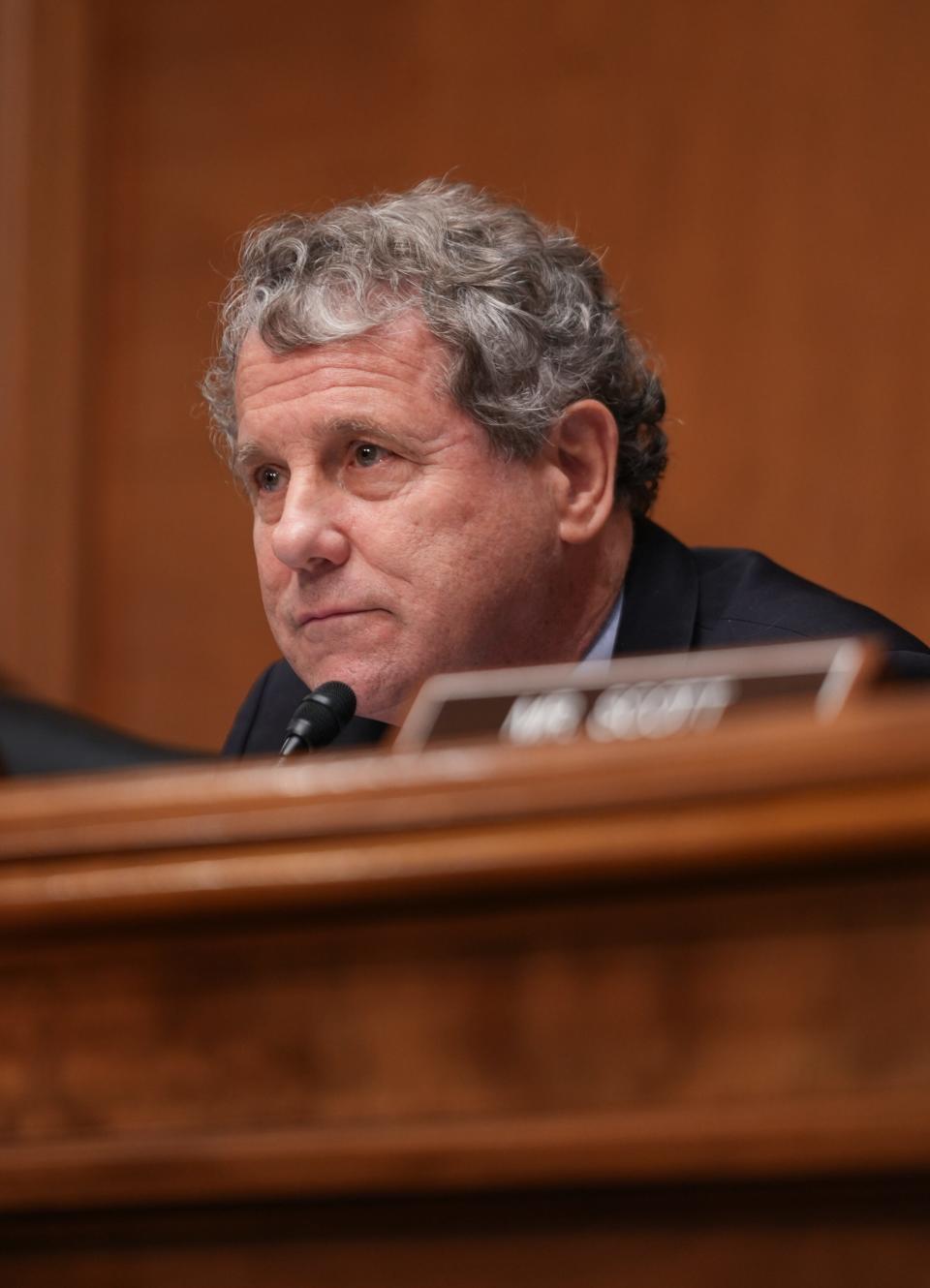How did abortion rights amendment pass in Ohio and what does it mean for future elections?

- Oops!Something went wrong.Please try again later.
Voters across Ohio voted to protect access to abortion and other reproductive rights Tuesday, rejecting bans and restrictions passed by the state's predominantly Republican Legislature.
"We did it," declared Dr. Marcela Azevedo, a founder of Ohio Physicians for Reproductive Rights, as abortion rights proponents cheered Tuesday night. "We're going to bed knowing that we own our own bodies."
But how did they do it?
In poll after poll and vote after vote, Americans are backing access to abortion. That was as true in an increasingly red state like Ohio as it was in the increasingly blue state of Michigan.
"Tonight we make history and we make a statement: When abortion is on the ballot, we win," said Kellie Copeland, executive director of Pro-Choice Ohio and a longtime advocate of reproductive freedom. "Ohio is not a red state. We're purple as hell, baby."

Voters support access to abortion
Issue 1 won overwhelmingly in Ohio's largest cities − passing with nearly 73% of the vote in Franklin County, 74% in Cuyahoga County and 65% in Hamilton County, according to final, unofficial results − but it also won in suburban counties like Delaware (59% of the vote), Lorain (62.4%) and Butler (50.6%). Eighteen counties that backed former President Donald Trump in 2020 voted for Issue 1, which passed 57-43% statewide.
In an August special election, Republicans attempted to make it harder to amend the state constitution, asking voters to raise the threshold to 60%. If that measure had passed, it would have blocked the abortion rights amendment's victory on Tuesday. But voters overwhelmingly rejected the August issue − a harbinger of what was to come.
In 2022, abortion rights proponents won in six states. They are eyeing several others in 2024, potentially driving Democrats to the polls during a presidential election. The winning streak comes after the U.S. Supreme Court overturned Roe v. Wade, sending decisions about abortion access back to state lawmakers, judges and voters.

These efforts are well-funded by national proponents of abortion access and progressive groups. They easily outspent their rivals, including Ohio's Catholic dioceses, which pitched in $1.7 million between Cincinnati, Columbus and Cleveland. Cincinnati Archbishop Dennis Schnurr, who led the Catholic Church's opposition to Issue 1 in southwest Ohio, described the amendment's passage Tuesday as "deeply disturbing."
Support for abortion rights is a setback for Republicans and abortion opponents who have successfully eroded abortion access in states like Ohio over decades. Abortion opponents could ask Congress for a 15-week abortion ban, but that undercuts their earlier arguments that states should decide their own fates.
As GOP politicians like to point out, Ohio isn't liberal California. But the Buckeye State passed an abortion rights measure anyway.

Ohio Republicans overreached and paid the price
Abortion opponents had a simple plea in the final weeks of the election: Vote against Issue 1, and we'll come up with a moderate, reasonable alternative.
But it was too late. Ohio's GOP-controlled Legislature and Republican Gov. Mike DeWine had already shown their cards by banning most abortions in 2019 and attempting to ban abortion at conception in 2022.
On the day the U.S. Supreme Court overturned Roe v. Wade, Ohio's abortion policy was no longer hypothetical. The worst-case scenarios that doctors had warned about in committee rooms were playing out in national headlines. A 10-year-old rape victim in Ohio was taken to Indiana for an abortion. Doctors were worried about losing their licenses or facing incarceration. An abortion clinic nearly closed.
The headlines only stopped when a Hamilton County judge temporarily blocked Ohio's abortion ban.
DeWine, a longtime abortion opponent, stepped in to fight Issue 1 after a messy and unpopular August election, but the GOP governor couldn't stop the abortion rights measure from passing.
Ultimately, DeWine and Ohio's Republican lawmakers were out of step with the will of the voters on abortion policy, and they paid the price at the ballot box. Voters taught politicians the same lesson Tuesday night when they legalized marijuana and in August when they rejected a measure to make it harder to amend the state constitution.
Like the “dog that catches the car,” said Dr. David Burkons, who runs Northeast Ohio Women’s Center, Republicans now know the electorate bites back. He hopes the Ohio victory for abortion rights helps the GOP reconsider hardline opposition to the procedure as a litmus test for its candidates and party platform.
Will GOP lawmakers remember this lesson when pitching unpopular policies?
"I remain skeptical of the ability of the Republican supermajority to do soul-searching," House Minority Leader Allison Russo, D-Upper Arlington, said Tuesday night. "But at the end of the day, the people of Ohio have spoken loudly and clearly on this issue, not just tonight but also in August. They want abortion rights and they want personal freedom."
Shortly after voters approved Issue 1, top Republican lawmakers were already promising to fight against abortion access in the Legislature and at the ballot box.
"Life is worth fighting for," said Senate President Matt Huffman, R-Lima, in a statement. "This isn't the end. It is really just the beginning of a revolving door of ballot campaigns to repeal or replace Issue 1."

U.S. Sen. Sherrod Brown still faces the toughest race of his political life in 2024
Even as Democrats savor their rare victory, all eyes are turning to 2024.
Do wins on abortion, marijuana and the August election help energize Democrats and remind them how to win in the Buckeye State? Maybe, but U.S. Sen. Sherrod Brown still faces the toughest race of his political career.
"We would be a little foolish to over-interpret tonight's results. We know that issues and candidates are not apples to apples," said Ohio Democratic Party Chairwoman Liz Walters, but she said Brown is a candidate who puts democracy first and fights for Ohioans' rights and that's a winning combination.
More: Ohio Sen. Sherrod Brown faces a tough election in 2024. And the stakes couldn't be higher
Brown has benefited from political tailwinds and weak opponents in past elections. That won't be the case in 2024 when he faces state Sen. Matt Dolan, Ohio Secretary of State Frank LaRose or businessman Bernie Moreno. Democratic President Joe Biden is unpopular in the state, which twice picked former President Donald Trump by 8 percentage points.
“This has very little impact on Sherrod Brown,” Republican strategist Mark Weaver said. “The abortion issue cuts across party lines. Sherrod Brown continues to be at risk because his working-class Democratic base has left him and the state has grown redder since he’s been in the Senate.”
Brown backed Issue 1 and ultimately voted for Issue 2 legalizing marijuana. Other ballot measures could be on the 2024 ballot along with the U.S. Senate race, including a $15 minimum wage, redistricting reform and the right to hunt and fish.
But Brown is ready for the fight, saying in a statement Tuesday night: "While my opponents work to ban abortion, I will continue fighting for and standing with the people of Ohio.”
Cincinnati Enquirer reporter Dan Horn and Akron Beacon Journal reporter Doug Livingston contributed to the article.
Jessie Balmert is a reporter for the USA TODAY Network Ohio Bureau, which serves the Columbus Dispatch, Cincinnati Enquirer, Akron Beacon Journal and 18 other affiliated news organizations across Ohio.
This article originally appeared on Cincinnati Enquirer: Analysis: Why Ohio Issue 1 won and what it means for future elections

